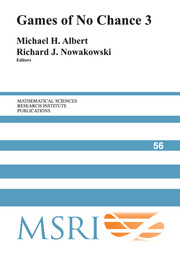Bibliography of Combinatorial Games
Published online by Cambridge University Press: 28 February 2011
Summary
What are combinatorial games?
Roughly speaking, the family of combinatorial games consists of two-player games with perfect information (no hidden information as in some card games), no chance moves (no dice) and outcome restricted to (lose, win), (tie, tie) and (draw, draw) for the two players who move alternately. Tie is an end position such as in tic-tac-toe, where no player wins, whereas draw is a dynamic tie: any position from which a player has a nonlosing move, but cannot force a win. Both the easy game of Nim and the seemingly difficult chess are examples of combinatorial games. And so is go. The shorter terminology game, games is used below to designate combinatorial games.
Why are games intriguing and tempting?
Amusing oneself with games may sound like a frivolous occupation. But the fact is that the bulk of interesting and natural mathematical problems that are hardest in complexity classes beyond NP, such as Pspace, Exptime and Expspace, are two-player games; occasionally even one-player games (puzzles) or even zero-player games (Conway's “Life”). Some of the reasons for the high complexity of two-player games are outlined in the next section. Before that we note that in addition to a natural appeal of the subject, there are applications or connections to various areas, including complexity, logic, graph and matroid theory, networks, error-correcting codes, surreal numbers, on-line algorithms, biology—and analysis and design of mathematical and commercial games!
- Type
- Chapter
- Information
- Games of No Chance 3 , pp. 491 - 576Publisher: Cambridge University PressPrint publication year: 2009

